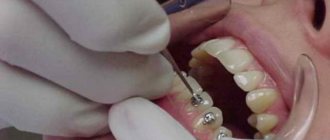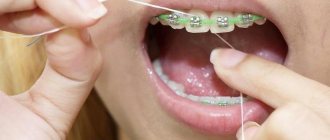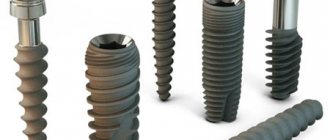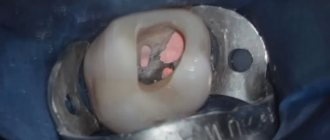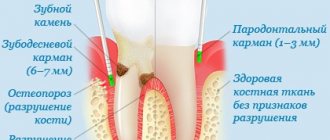Modern dental prosthetics can completely restore the aesthetics of the dentition and its chewing functions. People may face the need for surgical removal at any age. Among the achievements of orthopedic dentistry, anyone can choose a suitable replacement option. Dental prostheses are produced in different types, differing in the material of manufacture, cost, and service life. For the production of structures, alloys of precious metals, ceramics, special plastics, polymers, nylon and other types of raw materials are used.
There are two types of prosthetics after tooth extraction:
- Removable dental structures can be removed and put on by the patient as needed. The products are attached to the supporting teeth using hooks or micro-locks. For edentulous patients, models are used that are fixed to the gums using suction cups or a special gel.
- Fixed dentures are installed in the jaw (implants) or attached to supporting teeth (bridges).
Each category is represented by several options. Among them, dentists select the appropriate solution based on the condition of the oral cavity and the health of the patient.
Depending on the service life of the products, temporary and permanent dentures are distinguished. Models of the first type are designed to last only a few months. The products are used to temporarily close the postoperative gap.
Fixed dentures remain the most popular way to restore the beauty of a smile. This replacement option is more convenient compared to removable devices. It is easy to care for and helps preserve the natural functions of the dental system. Permanent prosthetics are performed in different ways:
- The installation of crowns made of metal ceramics or a metal alloy is performed on a previously prepared tooth. This method is used if the root is intact, but the top is destroyed.
- Implantation of one or more teeth involves inserting an artificial root into the jaw. A permanent or temporary crown is placed on it. This method is indicated for complete or partial edentia. Sometimes doctors use an implant as a support for a bridge.
- Bridges are placed after the amputation of several teeth located nearby.
- Adhesive structures are secured using an adhesive solution. In this case, there is no need to depulp the adjacent teeth. This restoration method is one of the most technologically advanced in orthopedic dentistry.
Prosthetics after tooth extraction and indications for the procedure
Installation of a denture allows you to completely restore the functional and aesthetic properties of the jaw apparatus. The indication for the procedure is single or multiple damage to the jaw as a result of trauma, surgical amputation due to advanced caries, or other diseases of the oral cavity.
If the crown is partially destroyed, a microprosthesis is installed instead of the usual one. This group includes inlays, veneers and ultraneers. The products effectively solve aesthetic problems with minimal trauma to natural bone and gum tissue.
What determines the service life?
On average, a crown can last 5-7 years, and a dental bridge - 7-11. No one can give accurate forecasts; this is influenced by many factors.
The main ones:
- Materials used for manufacturing. The most durable structures are made of metal, but they have one drawback - an unattractive appearance. Metal-ceramic crowns are a kind of compromise between aesthetics and durability. There are other raw materials, each of which has its own advantages and disadvantages. However, when restoring anterior teeth, ceramics are the best option.
- Specialist qualification. Precision manufacturing and correct installation play an important role. Only then does saliva and food not get under the prosthesis, the gums do not become inflamed, and the product itself fits without gaps or voids.
- Fixation method. Crowns based on zirconium dioxide and metal-ceramics are attached to a special material – “cement”. Over time, it deteriorates, causing a leak. Structures based on lithium disilicate are fixed using a special technique, which ensures a strong connection and extends service life.
- Care and daily hygiene. It is necessary to brush your teeth 2 times a day. For a more thorough cleaning, it is better to floss and rinse your mouth after every meal. It is recommended to have your teeth professionally cleaned by your dentist periodically.
- Condition of the tooth. Often patients come when it has already been destroyed to the level of the gum or below. This does not allow the structure to be completely sealed, which means it will not last long.
As we see, durability depends on many factors, but the experience and qualifications of a specialist and the correctly selected method of restoring lost units play a big role.
Contraindications
Thanks to the variety of techniques for each person, you can choose a way to restore the beauty of your smile. All dentures have indications for use and contraindications. The decision to replace a lost element after amputation is made by the attending physician based on the results of dental diagnostics, taking into account the age and condition of the body.
As for the general reasons, experts do not recommend performing surgical procedures if you are pregnant, undergoing rehabilitation after a serious illness or complex operation, or are sick with ARVI. You should not install implants or dentures during periods of exacerbation of chronic diseases, exhaustion or acute stress.
Tell your doctor if you are allergic to anesthetics or take any medications. Some drugs affect blood clotting and the rate of tissue regeneration. This can create problems during the procedure and while the wound is healing.
Often, poor oral hygiene is an obstacle to treatment. This temporary contraindication can be eliminated through therapeutic measures.
What is important for patients to know before installing a dental bridge?
Cement allows you to smooth out the inaccuracies of the dental bridge by choosing a more suitable position in the oral cavity. Thanks to this, the prosthesis does not need to be adjusted, ground or re-processed, provided that the inaccuracy is minimal, most often caused by changes in the prepared teeth in the interval between taking impressions and installing the prosthesis. This period can reach 2 weeks. Even with the use of temporary restorations, the prepared teeth may have slight deviations. High-quality products have a maximum fit; in the presence of cavities and large gaps between the support and the prosthesis, it is impossible to achieve a hermetically sealed fixation, therefore it is important that the dental bridge is made accurately. In large spaces under the denture, microbes can accumulate, which lead to the development of caries and gum disease.
The disadvantages of cement fixation are also considered to be the toxicity of some types of adhesives. The cement remains under the crown and practically does not interact with the tissues of the mucous membrane. However, some substances can accumulate and over time cause irritation, itching or burning of the gums. This mainly applies to compositions that harden due to a chemical reaction. Chemical cements erode over time, leading to delamination of the structure. This occurs unevenly, causing patients to experience breakage, injury, or loss of the prosthesis with simultaneous breakage of the supporting tooth. Basically, bridge failure occurs if the patient ignores signs of loosening or if there is a lot of stress placed on the dental bridge. When using modern cementitious compounds, the risk of developing allergies or inflammation is minimal. However, a specialist must conduct a diagnosis to determine whether there is an allergy to the substances that make up the material.
If a dental bridge is installed on dental implants, then when using one-step or one-stage implantation techniques, the gums on the day of prosthetics have damage - incisions, which are then sued. It is almost impossible to control the flow of adhesive, so when fixing, the doctor relies on his experience and knowledge. The entry of cement into the gum incision causes inflammation, pain and subsequent development of complications. If there is a lack of experience, the amount of cement can be much larger, which is why it can get under the gum and cause inflammation. If insufficient cement is used, there will be too little adhesive inside the abutment crown to provide a tight seal and long-term fixation of the prosthesis. When chewing, this factor can lead to breakage and loss of the denture.
To check the reliability of the fastening, an x-ray examination is performed. X-rays are used to determine the areas under the dental bridge where there is cement and where it has eroded over time. If the cement content is insufficient, the prosthesis must be removed and reinstalled. The dental bridge is separated using ultrasound. It acts on the cement and destroys it, after which the structure separates. When using this method, the risk of damage to the supporting ground teeth or loosening of the supporting implants is higher than with screw fixation. In addition, it is more difficult to control the reliability of the attachment, so patients may experience prosthesis loss and damage to the internal structures of the oral cavity. If cracks or chips form on the supporting teeth when the prosthesis detaches, then the dental bridge cannot be used again. It will not fit tightly to teeth whose relief has changed. For safe subsequent prosthetics, the structure is re-made so that there are no cavities inside the crowns that accumulate plaque and microbes.
The choice of fixation method depends on the type of structure and clinical picture. The doctor himself chooses the fastening method, which will provide reliable fixation for a long time, prevent loosening and protect the dental bridge from damage.
Installation of the prosthesis immediately after removal (within 24 hours)
Clients are always interested in how many days after an injury or surgery they can get dentures. Dentistry has express methods for instantly eliminating smile defects. There is no need to hide an ugly gap from others and experience discomfort when communicating! We are talking about simultaneous implantation, which is performed in one stage. The dentist installs an artificial root into the resulting hole and immediately puts on a crown, which is prepared in advance. It creates a load on the jaw apparatus and prevents atrophy.
Another option is immediate dentures, which are temporary and are designed for 3-4 months of use.
When is a crown placed on a living tooth?
The quality of endodontic treatment, which is carried out before dental prosthetics, largely depends on the presence or absence of pulp.
In most cases, it is depulpation that allows all manipulations to be carried out more thoroughly, which significantly reduces the risk of any complications. Treatment and installation of a crown on a living tooth requires local anesthesia. This method is performed extremely rarely, and the decision is made on an individual basis. This takes into account the level of tooth decay and the material used to make the crown. It is recommended to install only a zirconium crown or half-crown (like a veneer) on a living chewing tooth.
Expert opinion
Roman Borisovich Alekperov
orthopedic dentist
Experience: 24 years
If you are just planning to visit a surgeon for tooth extraction, consider the option of one-stage implantation. This unique method involves placing an implant into the resulting socket immediately after extraction. No additional manipulations - incisions or detachment of a mucosal flap, as with the classic protocol - are performed. This gentle method will allow you to resolve the issue of tooth restoration immediately at the time of its removal. Important: there are contraindications for immediate implantation! Please clarify the possibility of its use in your case during your consultation.
It is better to preserve a wisdom tooth if a number of conditions are met:
- There is an antagonist - that is, a similar tooth in the upper or lower row, actively performing a chewing function and in contact with the tooth, the fate of which is being decided in the doctor’s office.
- This wisdom tooth will be needed later, many years later, if the need for dental prosthetics with crowns suddenly arises.
- Caries or pulpitis of a problematic wisdom tooth can be treated qualitatively with the installation of a pin or crown.
Unfortunately, some general practitioners are too lazy to engage in long-term and labor-intensive treatment of wisdom teeth. Here you will need to show dexterity, because it is quite difficult to operate with instruments in the depths of the mouth. It is much easier to remove a tooth, and often the patient - especially at a young age - agrees to this proposal, trusting the doctor. In addition, few people think about the situation that may arise many decades later.
The sixth and seventh teeth, experiencing heavy chewing load, can collapse beyond repair. If the wisdom tooth were in place, it would be possible to install a bridge. And without it, a so-called “end defect” appears in the dentition. There are only two options: installation of a removable denture, or expensive dental implantation.
Advantages
If you lose several teeth in a row, dental bridges on implants are the right solution. Allows you to correctly distribute the load and not use healthy teeth.
- Neighboring teeth do not deteriorate. The supports are implants implanted into the jaw, and not your own teeth, which must be ground down.
- Durability Implants last a lifetime, and the service life of the prosthesis is at least twice as long as that of classic bridges.
- Aesthetics Crowns are no different from your own teeth. The aesthetic gingival contour is recreated.
- Affordability Savings compared to classic implantation, when each tooth is replaced with an implant and a crown.
What materials are they made of?
Dentures are manufactured in the Center’s own dental laboratory, you can choose the appropriate option to suit your taste and budget
- Metal-ceramic The base of the crowns is a metal alloy, the top is covered with ceramic mass. Relatively inexpensive, yet durable and quite aesthetic. The main disadvantage of metal ceramics is the ability to oxidize and cause a bluish outline to appear on the gums over time. Service life - 15 years or more .
- Zirconium Can be all-zirconium or coated with ceramics. They can withstand any load, do not deform, and retain their original appearance. Identical to natural teeth, the shade is selected individually. More expensive than metal-ceramic ones, but last longer. Service life - 25 years or more.
We offer patients the most profitable and practical methods, so we reserve the advantage for metal-free structures. In our Center, dental bridges are created in our own digital production using Zirkonzahn Schule technology or at the PROCERA (Nobel Biocare) plant in Sweden.
Advantages and disadvantages
When choosing between an implant and a bridge, it is necessary to highlight the advantages and disadvantages of both methods.
The advantages of implantation include:
- Possibility of long-term use. Many manufacturers offer a lifetime warranty on titanium root.
- Completely matches the shade of natural teeth. It is possible to make a crown that matches the natural color of the enamel 100%.
- Possibility of one-stage installation after tooth extraction. The procedure usually guarantees a shorter healing period.
- Preservation of natural teeth without grinding or depulping.
- The survival rate is almost 98% due to the use of hypoallergenic materials.
- Ensuring an ideal load on the gums and bone tissue, which eliminates early atrophic changes.
- Possibility of using implanted teeth as supporting teeth for other types of prosthetics.
The disadvantages of implantation include high cost, duration of the procedure (can reach a year), and many contraindications.
Bridges are a simpler design that is becoming less common today. The advantages of the method include low cost and the possibility of installation for some diseases of the oral cavity and atrophic processes.
Bridges have many more disadvantages, including:
- The need for grinding of abutment teeth. For a natural tooth, this is serious damage, which can subsequently cause its destruction.
- Short service life. A bridge will serve its owner for no more than 10 years.
- Bridges promote resorption. The jaw bones begin to gradually dissolve in those places where natural teeth are missing. The process leads to serious visual changes and complications for the patient.
- Improper load on bone tissue and, as a result, insufficient blood circulation, leading to atrophy.
- Impossibility of installing implants at the site where the bridge is fixed. Due to changes in bone tissue, installation of an artificial root will require preliminary surgery to restore the bone structure of the jaw.
- Discomfort. Bridges can rub the gums and cause pain in the supporting teeth.
This type of prosthetics is losing its popularity, but, unfortunately, it is the only option for those for whom implantation is contraindicated.
Caring for metal-plastic crowns
The rules for caring for a metal-plastic prosthesis are as follows:
- Eliminate nuts, seeds and any other solid foods from your diet.
- Minimize the consumption of beets, carrots, currants, red wine and other products containing natural or artificial colors.
- Maintain good oral hygiene.
On average, dentures of this type significantly change color and lose functionality after 2-3 years, after which they require replacement to avoid problems with the supporting teeth or implant. However, if you follow the rules of care, the service life can be extended to 5 years.
Full bridges for the lower and upper jaw
In case of complete edentia, fixed bridge structures are reinforced with a metal arch
The arch unites the crowns, increases the strength of the bridge and allows it to withstand severe chewing loads. The number of implants is determined depending on the clinical picture, anatomical features and jaw size.
- In the upper jaw, bone tissue has a lower density, therefore, during implantation, a larger number of implants are used - 8 pieces.
- On the bottom , on the contrary, the bone is denser, so 6 implants are enough for complete prosthetics. This is subject to standard jaw sizes. If the patient has a large jaw, two more implants are added to evenly distribute the load and ensure safe operation of the prosthesis.
A dental bridge with 6 implants is usually solid, but a denture with 8 implants can be made segmented - from four sections. This is a more convenient option - if necessary, you can remove only one segment, and not the entire prosthesis.
Also, in case of complete absence of teeth, the All-on-4 and All-on-6 protocols are used. 4 or 6 implants are installed on one jaw in a certain way, observing the principles of load distribution. Immediately on the day of implantation, a temporary non-removable adaptive prosthesis is installed, and after 6 months it is replaced with a permanent one.
What are the consequences of untimely replacement?
Over time, the material on which the crown is attached is washed away. As a result, minor cracks appear through which harmful microbes penetrate. The tooth begins to decay. Basically, these processes occur asymptomatically, and the person comes to the clinic too late. If replacement is not made at the right time, the likelihood of tooth loss increases significantly.
Also, poor-quality construction causes tissue inflammation. If it is not replaced, this will lead to further spread of the inflammatory process, the formation of bone pockets and local periodontitis. In this case, long-term treatment of teeth and gums will be required.
If you have any dentures, it is very important to visit your dentist regularly for checkups and have them professionally cleaned twice a year. This will allow you to notice violations in time and avoid lengthy and possibly expensive treatment.
Where to go for dental care in Ivanteevka and Shchelkovo?
If you need a crown, bridge, or implantation services, contact Sanident Comprehensive Dentistry. Our patients have the opportunity to receive a free consultation and undergo treatment at the most affordable price.
Dental prosthetics is one of the dental services provided by the clinic’s specialists at a high level.
Diagnostics and treatment are carried out using modern equipment, using high-quality raw materials. We provide a guarantee for all types of services.
When is it time to change?
The decision to replace the product can only be made by a specialist based on objective signs.
These include:
- the prosthesis or crown was installed a long time ago and its integrity is compromised;
- no clear fit;
- there are areas of plaque accumulation;
- the presence of signs of inflammatory nature, exposure of the root.
Specific symptoms will help you understand that it is better not to postpone a visit to a specialist.
It is necessary to change the design if:
- the tooth under the crown hurts;
- gums become inflamed;
- an unpleasant odor appeared;
- leftover food gets stuck;
- the system has become mobile;
- the lower jaw protruded forward, it became difficult to bite and chew food.
Postponing a visit to the dental clinic can cause a number of unpleasant consequences.
Content
- Is it possible to put a bridge on implants?
- Is it possible to install a bridge on an implant and your own tooth?
- Advantages of dental bridges on implants
- Implant-supported bridge
- How long does it take to get used to dental bridges?
- There is no need to depulp adjacent teeth
- What does a dental bridge look like?
- How long does a dental bridge last?
- How much does it cost to install a dental bridge?
- Full jaw dental bridge
- Cost of a metal-ceramic dental bridge
- Dental bridge materials
- Metal-ceramic dental bridge
- Plastic dental bridge
- Zirconium dioxide dental bridge
- Ceramic dental bridge
